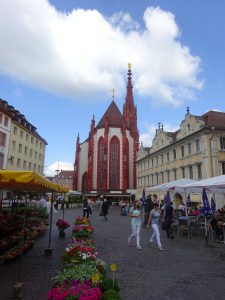Located on both banks of the Main River, Wurzburg is a town in the region of Lower Franconia in northern Bavaria, Germany. The town serves as the capital of the administrative district of Lower Franconia. Spoken in the region is the Franconian dialect.

Würzburg is celebrated for its beautiful art scene and abundance of wines and wineries. In contrast with the old-fashioned cobbled streets and striking baroque architectures, it also boasts a hip and lively nightlife.
However, before it became the city it is now, Würzburg used to be a Franconian duchy until 686, when it was Christianized by three Irish missionaries named Kilian, Kolonat, and Totnan.
Their mission, although successful, ended up killing them. They all eventually became saints. Saint Kilian at one point appeared on the city seal for 300 years, and the Würzburg Cathedral was also dedicated to him.
 The Würzburg Residence, the city’s crowning glory
The Würzburg Residence, the city’s crowning glory
For centuries, the prince-bishops seated in the diocese of Würzburg commanded much wealth and power. Under their reign, the city grew in luxuriousness, best exemplified by a vast compound in the city’s center.
Two prince-shops commissioned the construction of the grandiose palace compound, known as the Würzburg Residence or Residence in 1720. With funding from the von Schönborn brothers, Johann Philipp Franz and Friedrich Carl, the construction was supervised by many people including Baroque architects Johann Lukas von Hildebrandt and Maximilian von Welsch. The principal architect was Balthasar Neumann. It was also Neumann who created the palace’s Baroque grand staircase.
The vast frescoes adorning the interior of the building were painted by two Venetian painters, Giovanni Battista Tiepolo and his son Domenico, who served as his assistant. In fact, the palace’s immense ceiling fresco is widely considered to be the largest in the world.
The Würzburg Residence was completed in 1744, and is now a UNESCO World Heritage Site and considered one of the finest Baroque structures in Europe.
Although the palace, along with 90% of the city center, was destroyed by British bombers during an air raid in World War II, an ambitious rebuilding project spanning 20 years since, restored the city’s landscape and structures.
“While in port, during our AmaWaterways cruise, we really enjoyed the
Residence as well as the beautiful gardens in the back and the rose
garden to the side. Be sure and take a look if you have the time”
– Jan Baumgartner, Partner, Europeanbarging.com
Würzburg’s majestic Baroque and Romanesque churches
Like the Residence, all the city’s churches were demolished during the war, but fortunately they were all restored as well.
Among these churches is the Käppele, a chapel built in 1748 in late Baroque style. It used to be a small altar until Balthasar Neumann made plans to expand it into the chapel it is today. Its full name is Wallfahrtskirche Mariä Heimsuchung, or the Visitation of Mary, and serves to this day as a pilgrimage church.
Another church to visit is the Würzburg Cathedral which serves as the diocese of Würzburg’s seat. This Cathedral was dedicated to Saint Kilian and has served as the resting place for Würzburg’s prince-bishops for centuries. It is one of the largest Baroque-Romanesque church buildings in Germany and is considered a masterpiece of German architecture from the Frankish dynasty.
Many more churches, monuments, and works of art grace the streets and landscapes of Würzburg, making it one of the most scenic cities in Germany, due in part to its rich and grand history. Its old-fashioned charm mixed with the luxury of its past have branded this town as an undisputed must-visit.
To visit Wurzburg from a river cruise, we offer the Medieval Treasures, Europe’s Rivers and Castles, and Magnificent Europe itineraries on Amawaterways. For more information contact Europeanbarging.com 888-869-7907
